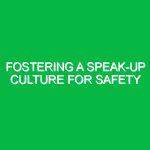Introduction to Psychological Safety in Teams
Psychological safety in teams refers to a shared belief that the team is safe for interpersonal risk-taking. This means team members feel they can speak up without fear of being ridiculed, ostracized, or penalized. In the context of Health, Safety, and Environment (HSE), psychological safety becomes particularly crucial. When teams feel psychologically safe, they are more likely to report hazards, share safety concerns, and engage in open discussions about risks, which are vital for maintaining a safe work environment.
Consider a construction site where workers hesitate to report unsafe conditions due to fear of backlash. This lack of communication can lead to severe accidents. Conversely, a team that promotes psychological safety encourages open dialogue about safety practices, ultimately leading to better compliance with safety regulations and improved overall well-being.
The Importance of Psychological Safety in HSE
The importance of psychological safety in teams cannot be overstated, particularly in the HSE domain. When workers feel safe to express concerns, they are more likely to identify potential hazards early. For instance, in a manufacturing plant where workers are encouraged to speak up, a minor issue, like a malfunctioning machine, can be reported before it escalates into a significant accident.
Moreover, fostering psychological safety can lead to a more engaged workforce. Employees who feel valued and heard are more likely to contribute to safety initiatives and participate in training sessions. This active involvement not only enhances their skills but also contributes to a culture of safety that permeates the entire organization.
Identifying Hazards and Risks Related to Psychological Safety
While psychological safety is crucial for a healthy work environment, it’s essential to recognize the hazards and risks associated with a lack of it. A culture that discourages open communication can lead to several issues, including:
1. Underreporting of Incidents
When team members fear negative repercussions, they may underreport accidents or near misses. This underreporting can create a false sense of security, leading to complacency in safety practices. For example, a safety officer in a chemical plant might not hear about a minor spill that could indicate a more significant problem, potentially resulting in a major incident.
2. Poor Decision-Making
Teams lacking psychological safety may struggle with decision-making. Without a platform to share diverse perspectives, important viewpoints may be ignored. Consider a scenario in a healthcare setting where nurses hesitate to voice concerns about patient safety protocols; this could lead to critical oversights that jeopardize patient health.
3. Increased Stress and Burnout
A high-stress environment where employees feel they cannot express their concerns can lead to burnout. Employees may feel trapped in a toxic culture, leading to high turnover rates and increased absenteeism. In an HSE context, this might result in a workforce that is not only less productive but also more prone to accidents due to fatigue and disengagement.
4. Resistance to Change
In an industry where safety protocols must evolve and adapt to new challenges, a lack of psychological safety can result in resistance to change. Employees may be reluctant to embrace new safety technologies or practices if they fear criticism or ridicule for suggesting improvements.
Implementing Safety Precautions and Best Practices
To mitigate the risks associated with psychological safety, organizations can implement several safety precautions and best practices:
1. Foster Open Communication
Encouraging open communication is paramount. Leaders should create an environment where employees feel safe to voice their concerns. Regular team meetings that emphasize safety and provide a platform for discussing issues can be beneficial. For example, a weekly safety huddle where team members are encouraged to share observations and concerns can help normalize open dialogue.
2. Provide Training on Psychological Safety
Providing training on psychological safety can help team members understand its importance and how to contribute to it. Workshops that focus on effective communication, conflict resolution, and active listening can empower employees to express themselves. A case study from a tech company showed that after implementing training sessions on psychological safety, employees reported a significant increase in their willingness to share safety concerns.
3. Encourage Leadership Involvement
Leadership plays a critical role in establishing psychological safety. Leaders should model the behaviors they wish to see in their teams, including admitting mistakes and seeking feedback. This approach encourages team members to follow suit. A personal anecdote from a project manager in the oil and gas sector highlights this; after openly discussing a mistake made during a project, the team felt more comfortable sharing their own concerns, leading to improved safety protocols.
4. Recognize and Reward Contributions
Recognizing and rewarding team members for their contributions to safety can reinforce the value of psychological safety. Public acknowledgment of individuals who report hazards or suggest improvements can motivate others to do the same. For example, a construction company implemented a “Safety Star” program, where employees who actively participated in safety discussions were recognized at company meetings. This initiative fostered a sense of community and shared responsibility.
5. Implement Anonymous Feedback Mechanisms
Sometimes, team members may still feel uncomfortable voicing their concerns openly. Implementing anonymous feedback mechanisms, such as suggestion boxes or digital platforms, can provide an alternative way for employees to share their thoughts. A manufacturing facility that adopted an anonymous reporting system saw a spike in reported near misses, which led to prompt corrective actions and enhanced safety measures.
Regulations and Standards Governing Psychological Safety in Teams
Understanding the regulations and standards that govern psychological safety in teams is vital for compliance and fostering a safe work environment. Various organizations and regulatory bodies have established guidelines to promote psychological safety, including:
1. Occupational Safety and Health Administration (OSHA)
OSHA emphasizes the importance of a safe and healthy work environment, which extends to psychological aspects. While OSHA does not have specific regulations solely dedicated to psychological safety, it recognizes that workplace stressors can contribute to occupational hazards. Employers are encouraged to address these factors as part of their overall safety programs.
2. National Institute for Occupational Safety and Health (NIOSH)
NIOSH has developed a framework for promoting organizational practices that support mental health and psychological safety. Their guidelines highlight the importance of creating a supportive work culture that prioritizes worker well-being.
3. ISO 45001
ISO 45001 is an international standard for occupational health and safety management systems. It encourages organizations to consider the psychological aspects of health and safety, including the importance of worker participation and communication in safety practices. Adopting ISO 45001 can help organizations systematically address psychological safety within their teams.
Conclusion: The Path Forward
Integrating psychological safety into teams within the HSE domain is not merely an optional enhancement; it is a necessary foundation for a safe and productive work environment. By recognizing the potential hazards associated with a lack of psychological safety and implementing best practices, organizations can foster an atmosphere where employees feel empowered to speak up about safety concerns.
The journey toward achieving psychological safety requires commitment from both leaders and team members. Through open communication, effective training, and a culture of recognition, teams can navigate the complexities of safety in the workplace, ultimately leading to a more resilient and engaged workforce. As we look toward the future of health, safety, and environment practices, the focus on psychological safety will undoubtedly play a critical role in shaping safer work environments for all.


